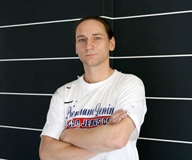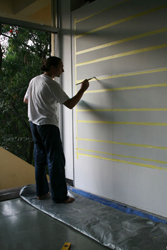

Founder Tour of Indiaart Featured Exhibitions Recent Additions Events by Indiaart Testimonials In Media Ordering & Buying Pay Indiaart Indiaart Blog Archives
paintings limited edition prints prints sculptures from private collections
Artists Photographers Sculptors Handcrafted Child Artists Old Masters Limited Edition Prints Young Artists Artists with Special Needs
Art India Foundation Photography Articles & Write-ups Exhibitions and Events Listings Handmade Cartoonists Obituary Resources

His paintings, executed directly on the wall, are monumental. They are a part of the architecture and a comment on it. An over dimensional part of the wall space is usually defined by a heavy monochromatic color space, the color he chooses is determined by the surrounding space, it could be complementary or a contrast to it; a few lines he uses are continuation of the lines that exist in the space around, the painting becomes thus a part of its surroundings, accenting thereby some aspects of the architecture that otherwise may not be registered.
The monochromatic use of color does not leave anything ambiguous; the expression becomes crystal clear and pure. The surface is a color, nothing more and nothing less. The color field in its monstrosity creates a mood, a sensation that could be overwhelming. Since no nuances arrest the eyes, they wander to the borders of the color field, drawn with extreme precision, this leads to other lines in the space drawn by the artist or those that exist around anyway. The lines drawn are very sharp, they could be 3 mm or 5 mm in thickness and some meters in length. The sharpness and precision of the lines are sometimes highlighted by making use of sharply cut metal objects that are installed on the wall, thus incorporating also the sculptural element, besides the architectural and the painterly elements, in the final "work" of Sigmund De Jong.
Sigmund De Jong has been showing his “Wall Concepts” in Holland and Germany since decades and has been invited to show his work in Pune by the India Art Gallery in cooperation with the Department of Foreign Languages, University of Pune .
